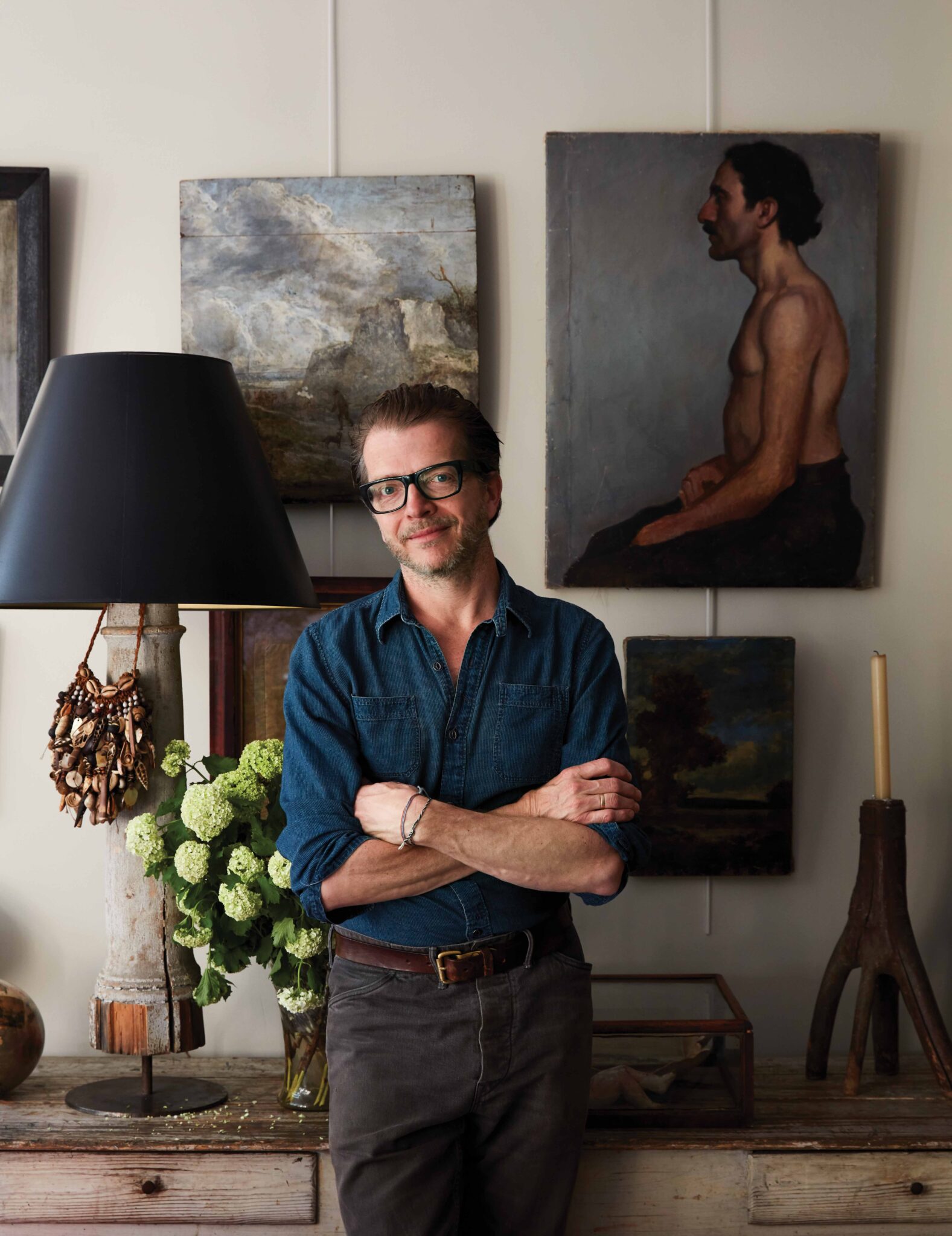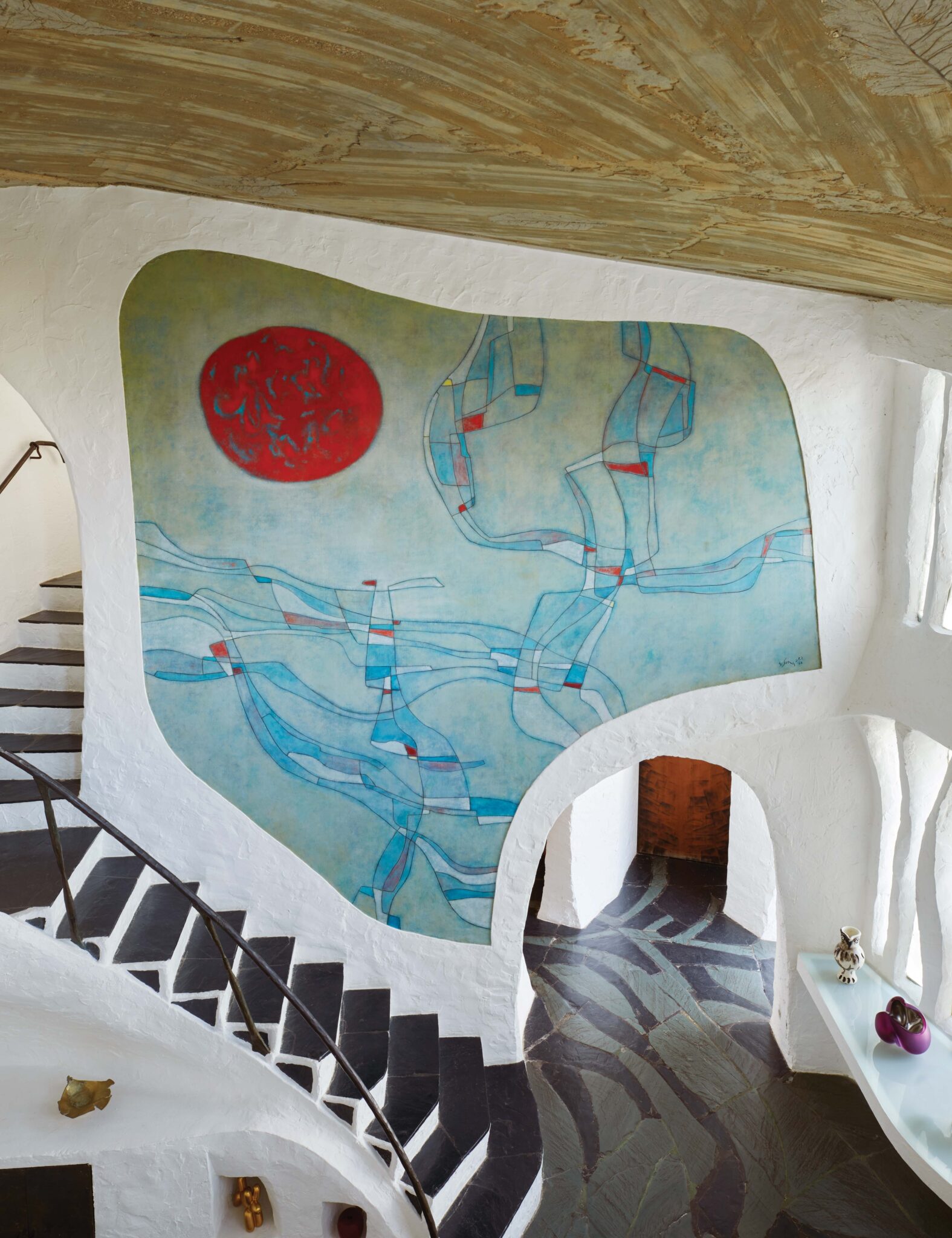Not everyone loves old things. But those of us who do tend to make it a way of life—and decorating. That’s certainly been the case for John Derian: beginning in the 1980s, when he started out in Boston, each of his homes has been a “whole atmosphere of ragamuffin delight,” as Virginia Woolf once wrote about Charleston Farmhouse.
-

John Derian in 1990, in the old Greek Revival on Columbia Street in Cambridge, Massachusetts. The wave running along the ceiling is a paper cutout he still has folded up in a suitcase.
DAVID C HALLIDAY -

Derian at home in his present-day apartment on Second Street above his shop in New York City’s East Village.
STEPHEN KENT JOHNSON/OTTO
Indeed, Bloomsbury was an early inspiration for Derian, but his aesthetic then and now possesses the Yankee austerity (and ingenuity) of his native Massachusetts. The result—an ineffable tangle of salty antiques and beloved mementoes, elegant lines and bright colors—feels both timelessly bohemian and perfectly unique.
-
 COURTESY OF JOHN DERIAN
COURTESY OF JOHN DERIANBedroom, 1986
Growing up in Watertown, Massachusetts, all I did was daydream and run around outside and make things. I tried art school, but after spending my second semester skipping class to visit flea markets, I realized it wasn’t for me. I ended up working weird jobs in Boston; I’d come home to my bedroom afterward and sit at my desk and draw things. This was my room in a house I lived in with roommates on Harvard Street in Cambridge. It was around that time I began collecting paper goods. The art above the bed is a magazine fold-out of Botticelli’s Venus that I copied a few times and then taped to the wall. I made those cushions from an antique printed linen fabric I found at a dollar-a-pound shop nearby—the type of place you have to get to at 8 a.m. and battle 100 other people for the best stuff. I wish I still had them.
-
 William Waldron
William WaldronLiving Room, 2006
In 1992, I moved to an apartment on Ridge Street on New York’s Lower East Side. It was only 550 square feet, but laid out really well. When this shot of the living room ran in Elle Decor in 2006, readers wrote hate mail about how it wasn’t decorator-y enough. It’s just what felt right to me. I got the sofa from the flea market in Paris, and the 19th-century wingback chair is covered in corduroy torn apart by my cat.
-
 Stephen Kent Johnson/OTTO
Stephen Kent Johnson/OTTOLiving Room, 2024
In 2017, I moved to Second Street, into the apartment above my shops. I kept the original tin ceiling and painted it and the walls the same color. That’s an 18th-century sofa in front of the bookshelf; the others are sofas I made with Cisco Brothers. I love antique paper boxes for storage.
-
 William Waldron
William WaldronKitchen, 2006
At Ridge Street, I used a 19th-century industrial table as my kitchen counter; it was just the right height. The étagère is industrial shelving from a freezer. I bought it when the NYC fish industry had to change all their shelving and people started selling the old ones in flea markets.
-
 Stephen Kent Johnson/OTTO
Stephen Kent Johnson/OTTOKitchen, 2024
I found the 19th-century clipper ship diorama over the antique sink in my Second Street kitchen in Antwerp—whenever I can buy a clipper ship, I do. Those pendants hanging over the antique kitchen island are by Robert Ogden. And that’s the same early-20th-century metal stool I had on Ridge Street.
-
 William Waldron
William WaldronDining Room, 2006
For some reason, other than at Thanksgiving, I didn’t use the dining room at Ridge Street all that often. I wonder why? Maybe it was haunted. The bookshelves were 18th-century boards. I still have the table and green metal garden chairs, the chandelier, and mirror. Even the same stereo system from the 1990s! I don’t listen to music much. I have one CD, the soundtrack to Diva. I’ve listened to it for 15 years.
-
 Stephen Kent Johnson/OTTO
Stephen Kent Johnson/OTTODining Room, 2024
On Second Street, I was finally able to use the 18th-century Swedish wall I’d found in Antwerp, shipped back to New York, and had in storage for years and years. It (almost) perfectly fit the space. I like how the mercury glass ball above the table adds sparkle.
See More of John Derian’s Homes Through the Years
THIS ARTICLE ORIGINALLY APPEARED IN VOLUME 11 OF FREDERIC MAGAZINE. CLICK HERE TO SUBSCRIBE!





















